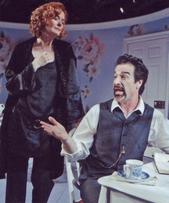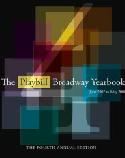SITE GUIDE
SEARCH
REVIEWS
REVIEW ARCHIVES
ADVERTISING AT CURTAINUP
FEATURES
NEWS
Etcetera and
Short Term Listings
LISTINGS
Broadway
Off-Broadway
NYC Restaurants
BOOKS and CDs
OTHER PLACES
Berkshires
London
California
New Jersey
DC
Connecticut
Philadelphia
Elsewhere
QUOTES
TKTS
PLAYWRIGHTS' ALBUMS
LETTERS TO EDITOR
FILM
LINKS
MISCELLANEOUS
Free Updates
Masthead
A CurtainUp Review
Is Life Worth Living?--an Exaggeration
By Elyse Sommer
|
We were all more or less happy and comfortable, good-tempered and jolly—until
these plays began to put ideas into our heads. We got suspicious of our neighbors and our own families. The young people got asking themselves 'Is life worth living?' If I've heard that question asked once in the last week I've heard it asked a dozen times. My own boy asked it of me! Sure never before did we think of asking ourselves such a ridiculous question. — Annie Twohig explaining why her husband is terminating the De La Mare Repertory company's contract for performing serious plays like Ibsen's Enemy of the People, A Doll's House and The Power of Darkness. |

Jordan Baker & Kevin Kilner
(Photo: Richard Termine) |
This latest offering from the Mint Theater —that intrepid excavator of buried theatrical gold— is a highlight of the current New York celebration of Irish theater (see links to other Festival shows we've reviewed below). Director Jonathan Bank has assembled an able and charming cast to give this gently endearing 1933 satire new life, and New York theater goers a two hour respite from cynical and tense times. It's fun but has something to say, and says it so that the author's fondness and respect for the characters is never in question.
You might say that the add-on title tag — An Exaggeration— applies to Robinson's tongue in cheek skewering of the dark psychological dramas he admired as much as he did Irish vilage life. While the provincial communities who book the De La Mare Repertory company headed Hector De La Mare (Kevin Kilner) and his wife Constance Constantia (Jordan Baker) have not flocked to the box office, Hector has not caved in and substituted more average folk fare. As he tells his latest employer/producer John Twohig (Paul O'Brien) he sticks with the more serious plays because "they may revolutionize some person's soul."
Except for Twohig's born-to-shop wife Annie (Bairbre Dowling) the people of Inish, though unfamilar with the nuances of serious modern dramas, turn out to be exactly the kind of audience Hector and Constance have yearned for: They not only come to see all the plays, but really get their transforming power. In fact, they get what they see so well that soon their uneventful, cheerful lives are transformed into dramas more real than the plays staged at the town's theater. Naturally, with so many offstage comings and goings demanding the Inish citizens' attention, the visiting acting company's full houses are suddenly distressingly empty. No wonder this play was originally entitled Drama at Inish!
The plot, plain and simple, depicts the ripple effect of two matinees and daily nights of realistic plays with mostly unhappy endings on the attitudes and views of the heretofore uneventful but pleasant world of the town. There are attempts to commit suicides, homicides and arson. John Twohig blows up when faced with the bill for his wife's latest Dublin shopping spree, declaring "Slowly my eyes are being opened, and I begin to see what a fool I've been all these years, just making a home for you, making a nest for you, making —a —" While Twohig is lost for the right words to end his scolding, sister Lizzie (Margaret Daly} jumps in with "Making a doll's house for her." Lizzie, who manages the family owned inn where the actors are staying also now sees her friendship with Peter Hurley (Jeremy Lawrence), the local district representative, as a tragically aborted romance. Hurley, who rarely makes his presence felt in the Irish Parliament, is not only bewildered by Lizzie's new view of their history togeter but finds himself casting a vote that upsets Inish's leading citizens (notably John Twohig) after seeing An Enemy of the People. The refusal of Christine Lambert (Leah Curney), the Twohigs' visiting accountant, to marry young Eddie Twohig (Graham Outerbridge) throws that young man into a fit of depression.
Since all these suddenly surfacing dramas are seen through a comic lens, don't expect Is Life Worth Living? to have an Ibsenesque ending. Instead, a suicidal leap in the sea only proves that it's hard to drown yourself at low tide, the rain that pounds against the window of the inn's drawing room where the play unfolds does inevitably turn into sunshine, and the all too effective De La Mare plays notwithstanding, all the theatrically induced gloom and doom lifts to make for one of the most fun happy endings I've seen in a while.
Under Mr. Bank's direction, the actors exaggerate the comic aspects of their characters just enough, but never stoop to hammy actor and Irish village carricatures. The only exception in the latter category is John Keating. This terrifically funny actor, something of an Irish version of the Seinfeld series' Kramer, is allowed to take his double assignment as Michael the Inn's theatrically ambitious Boots and as Mr. Slattery, the nephew of a rich but stingy and all too alive aunt.
The production values are modest but Susan Zeeman Roger's set is sufficiently detailed to evoke the cheery comforts of a seaside inn. Lighting designer Jeff Nellis keeps the rain that helps to steer bathers to the theater splashing against the room's window pane and sends a burst of sunlight into the room for the finale. Martha Hally has outfitted everyone attractively and authentically. Sound designer Jane Shaw completes the atmospheric staging with lively Irish music.
To keep its audiences laughing, the Mint has scheduled another backstage comedy for its next production, this one by Maurine Dallas Watkins, best known nowadays as the author of the play which seeded the hit musical Chicago. The production which will be directed by Martin Platt and feature Emmy Award winner Kristen Johnston will not be performed at the Mint's midtown home but at the downtown Lucille Lortel Theater. Like Is Life Worth Living? it promises to be worth seeing.
Irish Festival plays reviewed at Curtainup:
The Pride of Parnell Street at 59East 59
After Luke & When I Was God at the Irish Rep
|
Subscribe to our FREE email updates with a note from editor Elyse Sommer about additions to the website -- with main page hot links to the latest features posted at our numerous locations. To subscribe,
E-mail: esommer@curtainup.comesommer@curtainup.com
put SUBSCRIBE CURTAINUP EMAIL UPDATE in the subject line and your full name and email address in the body of the message -- if you can spare a minute, tell us how you came to CurtainUp and from what part of the country. |
|
Is Life Worth Living?--an Exaggeration by Lennox Robinson Directed by Jonathan Bank Cast: Jordan Baker (Constance Constanzia), Leah Curney (Christine Lambert), Margaret Daly (Lizzie Twohig), Bairbre Dowling (Annie Twohig), John Keating (Michael & William Slattery), Kevin Kilner (Hector de la Mare), Jeremy Lawrence (Peter Hurley), Erin Moon (Helena), Grant Neale (John Hegarty), Paul O'Brien (John Twohig), John O'Creagh (Tom Mooney) Graham Outerbridge (Eddie Twohig) Set Design: Susan Zeeman Rogers Costumes: Martha Hally Lighting: Jeff Nellis Sound: Jane Shaw Properties: Deborah Gaouette Dialects & Dramaturgy: Amy Stoller Stage Managers: Rebecca C. Monroe & Samone B. Weissman Running Time: 2 hours plus one intermission The Mint Theater Company 311 West 43rd Street (3rd floor) 212-315-0231 www.minttheater.org Tues through Thurs at 7:00 p.m. Fri & Sat at 8:00 p.m. Sat & Sun at 2:00 p.m. tickets $45— $55; $25 if under age 25: From 8/19/09; opening 9/14/09; closing 10/11/09, extended to 10/18/09 Reviewed by Elyse Sommer 9/11/09 |
|
REVIEW FEEDBACK Highlight one of the responses below and click "copy" or"CTRL+C"
Paste the highlighted text into the subject line (CTRL+ V): Feel free to add detailed comments in the body of the email. . .also the names and emails of any friends to whom you'd like us to forward a copy of this review. |






